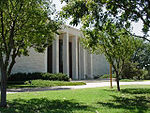Another Idea, BIRTHPLACES...
One of the most interesting things we personally like to do is visit the birthplace, childhood home or the last home of famous people. On our route to a new location we pull out our map book and see some of the interesting place place listed in red. We get to learn more of the personal details of the person such as, the home life when he/she was growing up, the family circumstances, what made them famous and how soon did that become apparent.Some of the famous person homes we've been to include:
Oliver Hardy of the comedy duo Laurel & Hardy was born in the little town of Harlem, Georgia. It's just 20 miles west of Augusta. They hold Laurel & Hardy celebration the first week of every October.
Marion Robert Morrison, aka John Wayne was born in Winterset, IA. If the name of the town sounds familiar that is because it's also the town about which the movie, "Bridges of Madison County" was filmed.
James Brown, the "God Father of Soul" was born in Barnwell, SC. He was born in a one-room shack in the woods of South Carolina, a few miles east of the Georgia border. His parents split ways when he was very young, and at the age of four, Brown was sent to Augusta, Georgia, to live with his Aunt Honey, the madam of a brothel. Growing up in abject poverty during the Great Depression, a young Brown worked whatever odd jobs he could find, for literally pennies. He danced for the soldiers at nearby Fort Gordon, picked cotton, washed cars and shined shoes. The other day, we attended a hockey game in the James Brown Arena in downtown Augusta.
George Washington, the first President of our country. He was born on a tobacco farm near Oak Grove, VA. It's now a National Park Service place to visit. Everyone know about his home, Mount Vernon, but few know about this gem.
Thomas Jefferson, everyone knows about Monticello, near Charlottesville, VA, but have you visited nearby Shadewell, VA where he was born?
Born nearby to Charlottesville and a few years later in the little town of Staunton, one can visit Woodrow Wilson's birth place and Presidential library.
In Ohio, Patterson Township you'll find the birthplace of Annie Oakley famed of the old west. Whether it be a pistol, rifle, or shotgun, the legendary markswoman Annie Oakley was masterful with them all. Dubbed "Little Sure Shot" by Chief Sitting Bull (she was 5 feet tall), her sharp shooting in Buffalo Bill's Wild West Show won her many awards and captivated audiences far and wide.
So you see, famous people have been born in common everyday America. Remember they weren't born famous in Hollywood or the White House. They grew up, most of them, much like you and me. If you check your map book for the little red letter indicator you'll find some amazing places to visit. Some of these places are free or nearly so. Get out and see America, you'll find some great people there...















